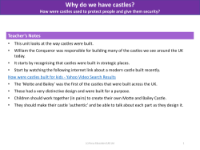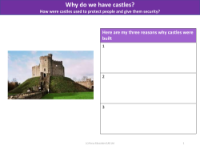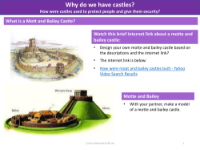How were castles used to protect people and to give them security? - Presentation

History Resource Description
Castles have historically served as formidable structures designed to safeguard and provide security for their inhabitants. The construction of castles was a strategic decision, often situated in locations that offered a tactical advantage, such as high ground or key crossing points. William the Conqueror is credited with the establishment of many castles across the United Kingdom, which have become iconic features of the landscape. The earliest form of these defensive structures was the 'Motte and Bailey' castle, characterized by its distinctive design and purpose-built nature. In educational settings, children are encouraged to collaborate in pairs to construct their own Motte and Bailey castles, ensuring authenticity and being able to explain the function of each part of their model.
The materials used in castle construction, such as wood, stone, or brick, were chosen for their durability and strength. Many castles initially built from wood were later reconstructed in stone to enhance their defensive capabilities, allowing them to be larger and more resilient. The evolution of castle architecture reflects the importance of these structures in military defense and as a means of asserting control over surrounding lands. Students are often tasked with researching and identifying the reasons behind the construction of castles, which include protection from invaders, demonstrating power, and controlling territory. Through the creation of models and the study of historical examples, learners gain a deeper understanding of the role castles played in providing security and protection in times of conflict.



